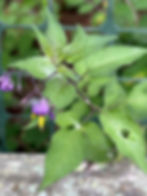Pulling Down the Nightshade
- bjmagnani
- Jul 18
- 3 min read
Enjoying grilling summer fruits and vegetables while sitting on the deck and soaking up the afternoon sun? Popular members of the Solanaceae family—tomatoes, eggplants, and potatoes—are likely taking on a nice char and are ready to accompany the main dish. These fruits (tomato and eggplant) and one vegetable (potato) are part of the nightshade family and harbor toxins in their leaves, stems, or skins. While some parts of the plant may be edible, others can only be consumed when mature or immature to avoid poisoning.

Two better-known nightshades from the genera Atropa and Solanum likely come to mind before those on your dinner plate. Atropa belladonna, commonly known as deadly nightshade, is a small shrubby plant that features a single deep purple flower and black berries. Ripe berries contain the common alkaloids atropine and, in small amounts, scopolamine. By blocking the cholinergic actions on the sphincter muscle of the iris and ciliary muscle of the eye, atropine produces pupil dilation. While atropine can be highly toxic, it is used medicinally. For example, it’s used to treat bradycardia (slow heart rate) and to reduce bodily secretions that are the result of anticholinesterase poisoning (think nerve agent poisonings).
As with most drugs, it’s the dose that makes the poison. Drops from the berries were once used as a beauty product due to their effect on the eyes. While a few drops in the eyes caused pupillary dilatation, creating the “beautiful lady” effect admired during Italy’s 17th century, higher doses produce toxic symptoms. The word Atropa is derived from Atropos, one of the three Greek fates, she who cuts the thread of life, thus resulting in death.
Ingesting deadly nightshade berries can produce symptoms such as dilated pupils, dry mouth, thirst, dry and flushed skin, vomiting, hallucinations, delirium, tachycardia (a rapid heart rate), and hyperthermia (an elevated body temperature). All parts of the plant are toxic.

Two other common nightshades, black nightshade (Solanum nigrum) and woody nightshade (Solanum dulcamara), are also toxic, but to a lesser extent. Shrubby black nightshade features star-shaped white flowers, and its mature berries are a deep purple black. Woody nightshade grows as a vine, and its star-shaped purple flowers form in small clusters, rather than a single large flower, like deadly nightshade. Ripe berries are red. Both Solanum species contain the alkaloid glycoside, solanine, which, while not as toxic as atropine, can produce vomiting and seizures. Other Solanum-related plants are Solanum tuberosum (the potato), Solanum lycopersicum (the tomato), and Solanum melongena (the eggplant).

Beware of the green parts of a potato skin, as well as any new sprouts. Those are the parts that contain solanine. Primary effects from ingesting solanine plant parts are usually gastrointestinal (abdominal pain, diarrhea, nausea, and vomiting), but like the effects from atropine, they can also include delirium, dilated pupils, and hallucinations.
Tomatoes contain tomatine, and to a lesser extent, atropine. The alkaloids are concentrated in the leaves, stems, and unripe fruit. Ripe red tomatoes have very low doses of tomatine. Interestingly, tomatoes were once considered poisonous and shunned gastronomically by Europeans due to their association with deadly nightshade. It wasn’t until the 1800s that tomatoes gained acceptability. That was good news for making tomato sauce (and for eating pasta).
Lastly, there is the lovely purple eggplant, which also contains solanine. The alkaloid is primarily found in the green parts and is also concentrated in the seeds. Younger plants tend to have fewer seeds.
It's the glycoalkaloids produced in tubers, leaves, roots, seeds, and sprouts that are responsible for the bitter flavor found in many of these foods. While some individuals are more sensitive to nightshade fruits and may want to consider eliminating them from their diet, no one should conclude a summer meal with a deadly nightshade berry tart. Better to stick with ice cream.